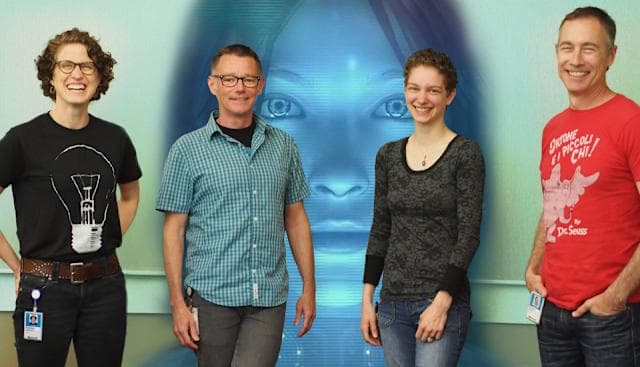Microsoft's Cortana: Building an AI with a Human Touch

Microsoft's Cortana: Building an AI with a Human Touch
Microsoft's foray into the competitive world of smartphone digital assistants is marked by the introduction of Cortana, a sophisticated AI designed for Windows Phone. This article delves into the extensive development process, the unique personality crafted for Cortana, and Microsoft's strategic vision for its AI assistant.
The Genesis of Cortana
Cortana's creation was a two-year endeavor involving a large team of scientists and product managers. The AI was meticulously modeled after real-life personal assistants, aiming to imbue it with human-like qualities. This approach was driven by research indicating that users are more likely to engage with AI that feels more human, fostering a sense of attachment. The team drew inspiration from various sources, including the AI character in the movie Her, and even the fictional Cortana from the Halo video game series, whose voice actress, Jen Taylor, also lends her talents to Microsoft's AI for chitchat interactions.
Crafting a Personality
Microsoft's primary objective was to differentiate Cortana by giving her a distinct personality. Project manager Susan Hendrich described Cortana's core traits as confident, caring, competent, loyal, helpful, eager to learn, and capable of witty banter. This focus on personality aims to make interactions more engaging and less transactional. The development team conducted interviews with real personal assistants to understand the nuances of their roles, how they interact with employers, and what makes them successful. These insights were crucial in shaping Cortana's conversational style and empathetic responses.
The Importance of Chitchat
Research revealed that a significant portion of AI interactions (around 40%) involves casual conversation or "chitchat." Microsoft recognized that users don't immediately dive into tasks when interacting with a human assistant; they engage in small talk first. Therefore, Cortana was designed to mirror this behavior, offering jokes, comebacks, and even Easter eggs (like a reference to Clippy) to build rapport and make the experience more enjoyable. This approach is intended to encourage users to interact with Cortana more frequently and build a stronger connection.
Navigating the Uncanny Valley
While aiming for human-like qualities, Microsoft is mindful of the "Uncanny Valley" – the phenomenon where AI that is almost, but not perfectly, human-like can evoke feelings of unease or revulsion. Cortana's creators emphasize transparency in her capabilities and limitations. If Cortana cannot fulfill a request, she is programmed to communicate this clearly and honestly, rather than making excuses or deflecting blame. This transparency is key to building user trust and managing expectations. The team acknowledges that imperfections become more visible as AI systems become more powerful.
Future Directions and Global Expansion
Microsoft has ambitious plans for Cortana's evolution. Future updates will focus on enhancing her short-term and long-term memory, enabling more natural, extended dialogues, and improving her ability to anticipate user needs. The company is also preparing for international expansion, with plans for the UK and China. This involves significant localization efforts to adapt Cortana's personality, language, and even voice to suit different cultural contexts. For instance, user studies indicated a need for a different voice profile in China, one that sounded more cheerful.
Competitive Positioning
Cortana enters a market already occupied by Apple's Siri and Google Now. Microsoft's strategy leverages Cortana's personality and conversational abilities as key differentiators. The project evolved from existing voice search features, and the decision to name the AI after the Halo character was a deliberate move to leverage existing brand recognition and character traits. Internal testing and external studies suggest that users respond more positively to AI with a strong, confident personality, reinforcing Microsoft's approach.
Conclusion
Cortana represents a significant investment by Microsoft in the AI space. By focusing on personality, conversational ability, and transparency, Microsoft aims to create a digital assistant that is not only functional but also relatable and engaging. As Cortana continues to evolve, Microsoft is committed to enhancing her capabilities, expanding her reach, and solidifying her place as a leading AI companion.
Key Features and Development Aspects:
- Human-like Personality: Modeled after real assistants and inspired by fictional characters.
- Chitchat Capability: Designed for casual conversation to build user rapport.
- Voice Talent: Features Jen Taylor, voice of Halo's Cortana, for chitchat.
- Transparency: Open communication about capabilities and limitations to build trust.
- Continuous Improvement: Regular updates and focus on memory and predictive abilities.
- Global Expansion: Plans for localization in markets like the UK and China.
- Competitive Differentiation: Focus on personality to stand out against Siri and Google Now.
Images:
- Image 1: Ethereal Cortana
- Image 2: Cortana with Halo reference
- Image 3: Cortana development reference
- Image 4: Cortana's progress discussion
- [Image 5: Joaquin Phoenix in 'Her'](https://s.yimg.com/ny/api/res/1.2/FKfVx1mp4ER1F7MDUG37Mw--/YXBwaWQ9aGlnaGxhbmRlcjt3PTY0MA--/https://o.aolcdn.com/images/dar/5845cadfecd996e0372f/6900d1c4d71dd4e94ed60244b9aeb27f43d29e2d/aHR0cDovL28uYW9sY2RuLmNvbS9kaW1zLXNoYXJlZC9kaW1zMy9HTE9CL2Nyb3AvMjg4MHgxNjIwKzArMC9yZXNpemUvNjMweDM1NCEvZm9ybWF0L2pwZy9xdWFsaXR5Lzg1L2h0dHA6Ly9vLmFvbGNkbi5jb20vaHNzL3N0b3JhZ2UvbWlkYXMv melakukannya4YTdjOGJjZThkODgyMmUwYWMwNjg1ZTU3ZTg2ZWYvMjAwMjI2MTI1Lzc5MTFmMTVhNThiYzQ1YjBhZjUwZDI3NjFjOWQ3YjYxLmpwZWc=)
- Image 6: Joe Belfiore introduces Cortana
Original article available at: https://www.engadget.com/2014-06-04-cortana-microsoft-windows-phone.html